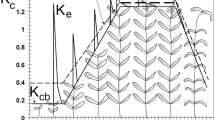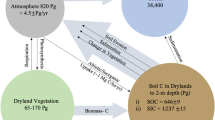Abstract
The stable isotopic composition of soil water is controlled by precipitation inputs, antecedent conditions, and evaporative losses. Because transpiration does not fractionate soil water isotopes, the relative proportions of evaporation and transpiration can be estimated using a simple isotopic mass balance approach. At our site in the shortgrass steppe in semi-arid northeastern Colorado, δ18O values of soil water were almost always more enriched than those of precipitation inputs, owing to evaporative losses. The proportion of water lost by evaporation (E/ET) during the growing season ranged from nil to about 40% (to >90% in the dormant season), and was related to the timing of precipitation inputs. The sum of transpiration plus evaporation losses estimated by isotopic mass balance were similar to actual evapotranspiration measured from a nearby Bowen ratio system. We also investigated the evapotranspiration response of this mixed C3/C4 grassland to doubled atmospheric [CO2] using Open-Top Chambers (OTC). Elevated atmospheric [CO2] led to increased soil-water conservation via reduced stomatal conductance, despite greater biomass growth. We used a non-invasive method to measure the δ18O of soil CO2 as a proxy for soil water, after establishing a strong relationship between δ18O of soil CO2 from non-chambered control (NC) plots and δ18O of soil–water from an adjacent area of native grassland. Soil–CO2 δ18O values showed significant treatment effects, particularly during a dry summer: values in ambient chambers (AC) were more enriched than in NC and elevated chamber (EC) plots. During the dry growing season of 2000, transpiration from the EC treatment was higher than from AC and lower than from NC treatments, but during 2001, transpiration was similar on all three treatments. Slightly higher evaporation rates from AC than either EC or NC treatments in 2000 may have resulted from increased convection across the soil surface from the OTC blowers, combined with lower biomass and litter cover on the AC treatment. Transpiration-use efficiency, or the amount of above-ground biomass produced per mm water transpired, was always greatest on EC and lowest on NC treatments.
Similar content being viewed by others
References
Allison G B and Barnes C J 1983 Estimation of evaporation from non-vegetated surfaces using natural deuterium. Nature301, 143–145.
Allison G B, Gat J R and Leaney F W J 1985 The relationship between deuterium and oxygen-18 delta values in leaf water. Chem. Geol. (Isot. Geos.) 58, 145–156.
Bariac T, Deleens E, Gerbaurd A, Andreé M and Mariotti A 1991 La composition isotopique (18O, 2H) de la vapeur d'eau transpiréetude en conditions asservies. Geochim. Cosmochim. Acta 55, 3391–3402.
Brunel J P, Simpson H J, Herczeg A L, Whitehead R and Walker G R 1992 Stable isotope composition of water vapor as an indicator of transpiration fluxes from rice crops. Water Resour. Res. 28, 1407–1416.
Bunce J A 2001 Direct and acclimatory responses of stomatal conductance to elevated carbon dioxide in four herbaceous crop species in the field. Global Change Biol. 7, 323–331.
Ciais P, Denning A S, et al. 1997a A three-dimensional synthesis study of ? 18O in atmospheric CO2. 1. Surface fluxes. J. Geophys. Res. 102, 5857–5872.
Ciais P, Tans P P, et al. 1997b A three-dimensional synthesis study of ? 18O in atmospheric CO2. 2. Simulations with the TM2 transport model. J. Geophys. Res. 192, 5873–5883.
Coplen T B 1994 Reporting of stable hydrogen, carbon and oxygen isotopic abundances. Pure Appl. Chem. 66, 273–276.
Dawson T E 1993 Water sources of plants as determined from xylem-water isotopic composition: Perspectives on plant competition, distribution, and water relations. In Stable Isotopes and Plant Carbon-Water Relations. Eds. J R Ehleringer, A E Hall and G D Farquhar. pp. 465–496. Academic Press, San Diego.
Dugas W A 1993 Micrometeorological and chamber measurements of CO2 flux from bare soil. Ag. Forest Meteorol. 67, 115–128.
Dugas W A, Heuer M L and Mayeux H S 1999 Carbon dioxide fluxes over Bermuda grass, native prairie, and sorghum. Ag. Forest Meteorol. 93, 121–139.
Farquhar G D, Lloyd J, Taylor J A, Flanagan L B, Syvertson J P, Hubick K T, Wong S C and Ehleringer J R 1993 Vegetation effects on the isotope composition of oxygen in atmospheric CO2. Nature 363, 439–443.
Harwood K G, Gillon J S, Griffiths H and Broadmeadow M S J 1998 Diurnal variation of ? 13CO2, ?C18O16O and evaporative site enrichment of ?H2 18O in Piper aduncum under field conditions in Trinidad. Plant Cell Environ. 21, 269–283.
Hesterberg R and Siegenthaler U 1991 Production and stable isotopic composition of CO2 in a soil near Bern, Switzerland. Tellus 43B, 197–205.
Hsieh J C C, Chadwick O A, Kelly E F and Savin S M 1998 Oxygen isotopic composition of soil water: Implications for partitioning evapotranspiration. Geoderma 82, 269–293.
Jackson R B, Sala O E, Paruelo J M and Mooney H A 1998 Ecosystem water fluxes for two grasslands in elevated CO2: A modeling analysis. Oecologia 113, 537–546.
Jarvis P G and McNaughton K G 1986 Stomatal control of transpiration: Scaling up from leaf to region. Adv. Ecol. Res. 15, 1–49.
Kattenberg A, Giorgi F, Grassl H, Meehl G, Mitchell J, Stouffer R, Tokioka T, Weaver A and Wigley T 1996 Climate models-Projections of future climate. In Climate Change 1995: The Science of Climatic Change. Published for the Intergovernmental Panel on Climate Change. Ed. J Houghton et al. pp. 285–358. Cambridge University Press, Cambridge.
Lauenroth W K and Milchunas D G 1991 The shortgrass steppe. In Natural Grasslands, Introduction and Western Hemisphere. Ed. R T Coupland. pp. 183–226. Elsevier, Amsterdam.
Longdoz B, Yernaux M and Aubinet M 2000 Soil CO2 efflux measurements in a mixed forest: Impact of chamber disturbances, spatial variability and seasonal evolution. Global Change Biol. 6, 907–917.
Lund C P, Riley W J, Pierce L L and Field C B 1999 The effects of chamber pressurization on soil-surface CO2 flux and the implications for NEE measurements under elevated CO2. Global Change Biol. 5, 269–281.
Majoube M 1971 Fractionnement en oxygene 18 et en deuterium entre l'eau et sa vapeur. J. Chim. Phys. 10, 1423–1436.
McNaughton K G and Jarvis P G 1991 Effects of spatial scale on stomatal control of transpiration. Ag. Forest Meteor. 54, 279– 302.
Meyers T P 2001 A comparison of summertime water and CO2 fluxes over rangeland for well watered and drought conditions. Ag. Forest Meteorol. 106, 205–214.
Miller J, Yakir D, White J and Tans P 1999 Measurement of 18O/16O in the soil-atmosphere CO2 flux. Global Biogeochem. Cycles 13, 761–774.
Moreira M Z, Sternberg L d S L, Martinelli L A, Victoria R L, Barbosa E M, Bonates L C M and Nepstad D C 1997 Contribution of transpiration to forest ambient vapour based on isotopic methods. Global Change Biol. 3, 439–450.
Morgan J, LeCain D, Mosier A and Milchunas D 2001 Elevated CO2 enhances water relations and productivity and affects gas exchange in C3 and C4 grasses of the Colorado shortgrass steppe. Global Change Biol. 7, 451–466.
Owensby C E, Ham J, Knapp A and Auen L 1999 Biomass production and species composition changes in a tallgrass prairie ecosystem after long-term exposure to elevated atmospheric CO2. Global Change Biol. 5, 497–506.
Paruelo J M, Sala O E and Beltran A B 2000 Long-term dynamics of water and carbon in semi-arid ecosystems: a gradient analysis in the Patagonian steppe. Plant Ecol. 150, 133–143.
Pearcy R W, Ehleringer J R, Mooney H A and Rundel P W 1989 Plant Physiological Ecology Field Methods and Instrumentation. Chapman and Hall, London.
Pendall E 1997 Precipitation Seasonality Recorded in D/H Ratios of Pinyon Pine Ccellulose in the Southwestern US. Ph.D. Dissertation, The University of Arizona, Tucson.
Pendall E, Leavitt S W et al. 2001 Elevated CO2 stimulates soil respiration in a FACE wheat field. Basic Appl. Ecol. 2, 193–201.
Penman H L 1948 Natural evaporation from open water, bare soil and grass. Proc. Roy. Soc. London 193, 120–145.
Peylin P, Ciais P, Denning A S, Tans P P, Berry J A and White J W C 1999 A 3-dimensional study of the ? 18O in atmospheric CO2: contribution of different land ecosystems. Tellus 51B, 642–667.
Reynolds J F, Kemp P R and Tenhunen J D 2000 Effects of longterm rainfall variability on evapotranspiration and soil water distribution in the Chihuahuan Desert: a modeling analysis. Plant Ecol. 150, 145–159.
Riley W J, Still C J, Torn M S and Berry J A 2002 A mechanistic model of H2 18O and C18OO fluxes between ecosystems and the atmosphere: Model description and sensitivity analyses. Global Biogeochem. Cyc. 10.1029/2002GB001878.
Stern L A, Amundson R and Baisden W T 2001 Influence of soils on oxygen isotope ratio of atmospheric CO2. Global Biogeochem. Cyc. 15, 753–759.
Tang K and Feng X 2001 The effect of soil hydrology on the oxygen and hydrogen isotopic compositions of plants' source water. Earth Planet. Sci. Lett. 185, 355–367.
Thornthwaite C W 1948 An approach toward a rational classification of climate. Am. Geogr. Rev. 38, 55–94.
Van Oijen M, Schapendonk A C H M, Jansen M J H, Pot C S and Maciorowski R 1999 Do open-top chambers overestimate the effects of rising CO2 on plants? An analysis using spring wheat. Global Change Biol. 5, 411–421.
Volk M, Niklaus P A and Korner C 2000 Soil moisture effects determine CO2 responses of grassland species. Oecologia 125, 380–388.
Wang X F and Yakir D 2000 Using stable isotopes of water in evapotranspiration studies. Hydrol. Proc. 14, 1407–1421.
White J W C, Cook W R, Lawrence J R and Broecker W S 1985 The D/H ratios of sap in trees: Implications for water sources and tree ring D/H ratios. Geochim. Cosmochim. Acta 49, 237–246.
Wilson K, Carlson T and Bunce J 1999 Feedback significantly influences the simulated effect of CO2 on seasonal evapotranspiration from two agricultural species. Global Change Biol. 5, 903–917.
Zimmerman U, Ehhalt D and Munnich K O 1967 Soil-water movement and evapotranspiration: Changes in the isotopic composition of the water. In Isotopes in Hydrology. pp. 567–585. International Atomic Energy Agency, Vienna.
Author information
Authors and Affiliations
Rights and permissions
About this article
Cite this article
Ferretti, D.F., Pendall, E., Morgan, J.A. et al. Partitioning evapotranspiration fluxes from a Colorado grassland using stable isotopes: Seasonal variations and ecosystem implications of elevated atmospheric CO2 . Plant and Soil 254, 291–303 (2003). https://doi.org/10.1023/A:1025511618571
Issue Date:
DOI: https://doi.org/10.1023/A:1025511618571




